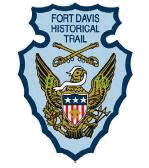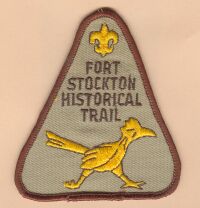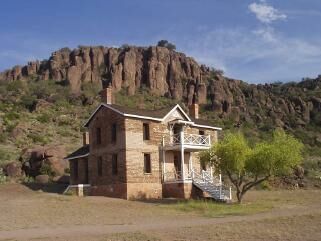 |
Four Historical Trails The “West” was won this part of the country
over a hundred and fifteen years ago when most of the
Forts in this area were closed. Many youth
and adults were unaware of the importance those forts
played in the settling of West Texas. The newest trail
to be approved by the Boy Scouts of America is the Ft.
Davis Historical Trail. This new trail was developed
by David O'Neill, Field Director of the Buffalo Trail
Council. The “West” was won this part of the country
over a hundred and fifteen years ago when most of the
Forts in this area were closed. Many youth
and adults were unaware of the importance those forts
played in the settling of West Texas. The newest trail
to be approved by the Boy Scouts of America is the Ft.
Davis Historical Trail. This new trail was developed
by David O'Neill, Field Director of the Buffalo Trail
Council.
David O'Neill was a former Eagle Scout in Concho Valley Council and had hiked the Fort Concho and Fort McKavett trails as a Scout. After moving to Buffallo Trail Council as a professional Scouter, he became interested in Ft. Davis and felt a need to develop a trail there. It was approved by the Boy Scouts of America in 2007 and has become a part of the approved historical trails of the BSA.
To help the youth to become a part of this history, the Concho Valley Council established three historical trails for youth and adults to hike and become eligible for a historical patch, and in the case of one trail, a metal. Fort McKavettThe patch and metal were designed by Scouter Ray Kedziora, using a photo of an old dead tree with the fort flag pole in the background. Edward J. Trust, a senior at Angelo State University and James L. Dreyer, a local radio announcer, developed a slide show to promote the trail. This trail is still in use today with a revised trail guide that requires a person to fill in the blanks as they hike the trail and does not require one to camp overnight or cook meals at Camp Sol Mayer. The outline of the Fort McKavett HIstorical Trail can be viewed and downloaded at Fort McKavett Historical Trail. Fort ConchoThe next trail that was established was the Fort Concho Historical Trail on October 1, 1981, that started at the old Fireman’s Park on Concho Street in downtown San Angelo and went two miles to end up at Fort Concho. The hikers, using a “fill in the blanks” guide sheet, walked through historical San Angelo and learned about the early settlement before crossing the North Concho River and walking through Fort Concho. The walk and tour took about two hours. The trail is still popular today and used mostly by Cub Scouts. The trail has been updated twice, once in 1996 by Frank Hilton and again in 2006 by Suzanne Campbell, Curator of the West Texas Collection and Lisa Mahler, Office Manager at Concho Valley Council, BSA. Also, a new patch was designed in 2006 by Hugh Campbell of San Angelo. The outline of the Fort Concho Historical Traill can be viewed and downloaded at: Fort Concho Historical Trail. Fort Stockton The last
historical trail in the Concho Valley Council to be
established was the Fort Stockton Historical Trail on
September 21, 1985 when 178 Boy Scouts, Cub Scouts and
Girl Scouts hiked the trail. This three-mile
walk started in front of the Annie Riggs Memorial
Museum on Callaghan Street in Fort Stockton and took
the group through both the location of Camp Stockton
and Fort Stockton. It also took the group
through St. Gail, the little settlement that grew
beside the military fort. A special guide was
used by the participants. A special thanks went
to Mary Kay Shannon, Curator of the Annie Riggs
Memorial Museum for her research and help in making
this trail possible. This trail was discontinued
in April 1992 when they ran out of patches and decided
not to order anymore. At the same time Fort
Stockton was ungoing some major repairs and
renovation. The last
historical trail in the Concho Valley Council to be
established was the Fort Stockton Historical Trail on
September 21, 1985 when 178 Boy Scouts, Cub Scouts and
Girl Scouts hiked the trail. This three-mile
walk started in front of the Annie Riggs Memorial
Museum on Callaghan Street in Fort Stockton and took
the group through both the location of Camp Stockton
and Fort Stockton. It also took the group
through St. Gail, the little settlement that grew
beside the military fort. A special guide was
used by the participants. A special thanks went
to Mary Kay Shannon, Curator of the Annie Riggs
Memorial Museum for her research and help in making
this trail possible. This trail was discontinued
in April 1992 when they ran out of patches and decided
not to order anymore. At the same time Fort
Stockton was ungoing some major repairs and
renovation.
All three
trails and guides were developed under the guidance
of Frank T. Hilton, then Program Director of the
Concho Valley Council, who wrote the trail guides.
Return to Home Page |
